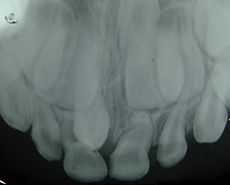Hyperdontia
| Hyperdontia | |
|---|---|
 Supernumerary teeth in the premaxillary area | |
| Classification and external resources | |
| ICD-10 | K00.1 |
| ICD-9 | 520.1 |
| MeSH | D014096 |
Hyperdontia is the condition of having supernumerary teeth, or teeth that appear in addition to the regular number of teeth. They can appear in any area of the dental arch and can affect any dental organ.
Types

Supernumerary teeth can be classified by shape and by position. The shapes include the following:
- Supplemental (where the tooth has a normal shape for the teeth in that series);
- Tuberculate (also called barrel shaped);
- Conical (also called peg shaped);
- Compound odontoma (multiple small tooth-like forms);
- Complex odontoma (a disorganized mass of dental tissue)[1]
When classified by position, a supernumerary tooth may be referred to as a mesiodens, a paramolar, or a distomolar.[1]
The most common supernumerary tooth is a mesiodens, which is a malformed, peg-like tooth that occurs between the maxillary central incisors.
Fourth and fifth molars that form behind the third molars are another kind of supernumerary teeth. [2]
Causes
There is evidence of hereditary factors along with some evidence of environmental factors leading to this condition. Hyperdontia is rare in people with no other associated diseases or syndromes.[3] Many supernumerary teeth never erupt, but they may delay eruption of nearby teeth or cause other dental or orthodontic problems.[4][5] Molar-type extra teeth are the rarest form. Dental X-rays are often used to diagnose hyperdontia.
It is suggested that supernumerary teeth develop from a second tooth bud arising from the dental lamina near the regular tooth bud or possibly from splitting the regular tooth bud itself. Supernumerary teeth in deciduous (baby) teeth are less common than in permanent teeth.
Related conditions
A similar condition is hypodontia, in which there are fewer than the usual number of teeth.
Hyperdontia is seen in a number of disorders, including Gardner's syndrome and cleidocranial dysostosis, where multiple supernumerary teeth are seen that are usually impacted.
References
- ↑ 1.0 1.1 Oxford Handbook of Clinical Dentistry
- ↑ Kokten G, Balcioglu H, Buyukertan M. Supernumerary Fourth and Fifth Molars: A Report of Two Cases. Journal of Contemporary Dental Practice, 2003 November; (4)4:067-076. Page accessed December 13, 2010.
- ↑ M.N. Pereira, L.E. de Almeida, M.T. Martins et al. (October 2011). "Multiple hyperdontia: Report of an unusual case". American Journal of Orthodontics and Dentofacial Orthopedics 140 (4): 580–584. doi:10.1016/j.ajodo.2010.02.038. PMID 21967947. Retrieved March 25, 2014.
- ↑ Vahid-Dastjerdi E, Borzabadi-Farahani A, Mahdian M, Amini N (2011). "Supernumerary teeth amongst Iranian orthodontic patients. A retrospective radiographic and clinical survey.". Acta Odontol Scand. 69 (2): 125–128. doi:10.3109/00016357.2010.539979. PMID 21142585.
- ↑ Fleming PS, Xavier GM, DiBiase AT, Cobourne MT (2010). "Revisiting the supernumerary: the epidemiological and molecular basis of extra teeth.". Br Dent J. 208 (1): 25–30. doi:10.1038/sj.bdj.2009.1177. PMID 20057458.
External links
- Tooth Conditions and Abnormalities at mchoralhealth.org
- Supernumerary and Extra teeth
- Supernumerary Teeth -An Overview of Classification, Diagnosis and Management
| ||||||||||||||||||||||||||||||||||||||||